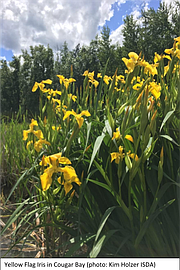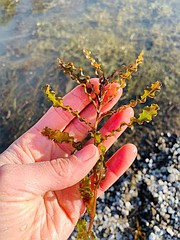Our Gem Coeur d’Alene Lake Collaborative
Coeur d'Alene Press | UPDATED 5 years, 4 months AGO
Aquatic invasive species (AIS) are plants, animals, and other organisms that are introduced by humans to new waterways and cause harm to our environment and economy. AIS invade aquatic ecosystems beyond their natural and historic range often outcompeting native species because they have no natural predators to limit their reproduction. “Invasive” is the right word to describe these organisms that overwhelm marine and freshwater environments including wetlands, lakes, rivers, irrigation systems, hydroelectric systems, and aquaculture facilities.
The Idaho State Department of Agriculture coordinates a statewide AIS management and control program, acting to protect the integrity of the state’s waterbodies from the biological degradation caused by aquatic plants and pests. This program includes statewide watercraft inspection stations checking boats for invasive Zebra and Quagga mussels, along with other AIS.
So far in 2020, over 88,000 watercraft inspections have been performed and 23 mussel-fouled boats have been found. Since 2009, more than 700,000 inspections have been conducted and 290 mussel-fouled boats have been intercepted.
The public plays a huge role in the prevention of the spread of AIS. Anyone boating in Idaho waters must buy an Idaho Invasive Species Fund sticker from Idaho Parks and Recreation. The fees generated from the sale of these stickers fund vessel inspections, washing stations, and informational materials that help Idaho prevent the introduction and spread of aquatic invasive species. Water recreators should also clean, drain, and dry all equipment after each use, especially if moving between different waterbodies.
AIS are often highly competitive, persistent, and can create monocultures that have the potential to crowd out, displace, or otherwise harm native species and habitats and disrupt healthy ecosystem functions. It is extremely difficult to control the spread of AIS once established. AIS spread through aquatic recreation, aquaculture, water gardens, international travel, and release of aquatic pets into the wild.
AIS can include plants, insects, fish, reptiles, mollusks, crustaceans, and amphibians. Other aquatic invasive organisms include pathogens (disease-causing organisms) such as molds, fungi, bacteria, and viruses. Idaho has 16 species of aquatic noxious weed species. Some AIS found in regional waterbodies are Asian Clams, Eurasian Watermilfoil, a hybrid species of Milfoil, Purple Loosestrife, Common Reed, Flowering Rush, Yellow Flag Iris, and Curly-Leaf Pondweed. All are aggressively invasive.
The damage caused by AIS threaten local economies by damaging critical industries such as fisheries, agriculture, recreation and tourism. Idaho is not alone in facing these threats, there is growing national awareness of the need to prevent and control invasive species. Nationally, the cost to control invasive species and the damages they inflict upon property and natural resources is estimated at $137 billion annually.
Working together, we can all help to protect the economic, recreational and aesthetic uses of Idaho’s water bodies. Preserving the water quality, biodiversity and natural aquatic ecosystems of our beloved wetlands, lakes, and rivers for generations to come!
Learn more:
Kootenai County, https://www.kcgov.us/393/Aquatic-Weed-Projects
Idaho State Department of Agriculture, http://invasivespecies.idaho.gov
• • •
The Our Gem Coeur d’Alene Lake Collaborative is a team of committed and passionate professionals working to preserve lake health and protect water quality by promoting community awareness of local water resources through education, outreach and stewardship. Our Gem includes local experts from the University of Idaho Community Water Resource Center, Coeur d’Alene Tribe Lake Management Department, Idaho Department of Environmental Quality, Kootenai Environmental Alliance, Coeur d’Alene Regional Chamber of Commerce, and CDA 2030. www.uidaho.edu/ourgem





